
High Plains Gardening
The gardening website of the Texas High Plains Region
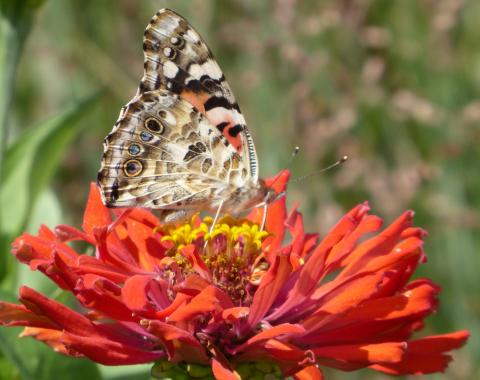
I didn’t set out to make a butterfly garden.
A few years ago, I made it a practice to look for pollinators, mainly bees, on flowers in my garden, to determine whether they were beneficial to the pollinators. Over the course of the past five years, and mainly the last two years, I paid particular attention to the butterflies that visited.
(Throughout this article, at the end of paragraphs, I've identified the butterflies and plant pictured. Painted lady butterfly with 4 small eyespots on zinnia at left, and the American lady on Salvia farinacea 'Cathredal Deep Blue' at right. Note American lady has two large eyespots.)
My front garden is a full sun garden, unlike most of our landscape now that our trees have grown. My original plan for this garden was for a showy three-seasons-of-interest garden, with an emphasis on late summer to fall.
My theme was influenced early in my gardening life (20+ years ago) by the book The Garden in Autumn, by Allen Lacy, where he made a case for planting fall gardens, given that our climate favors one. Lacy’s book had the most profound impact on the way I view my garden, especially the front garden, to this day. I took the challenge and decided one focus would be an autumn garden.
A second focus was to have our front garden with three seasons of interest, spring through fall. This was a more difficult task. Finding plants that bloomed in the month of June proved to be the most challenging. The front garden during the transition from late spring to summer had few flowering plants. After the burst of color in late spring, a period of flower dormancy set in with hot June temperatures until mid summer with the blooms that would take it through the end of October, and in a good year, November. (Trio of queen butterflies on Gregg's blue mist at left.)
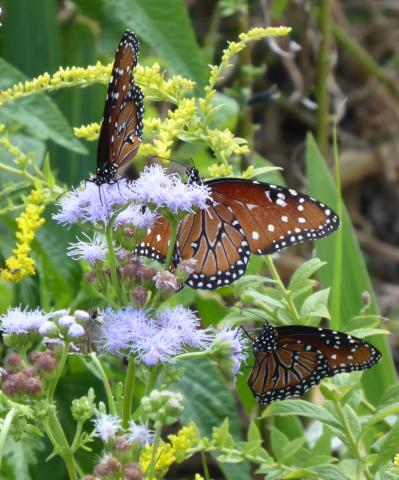
Over the years, another consideration became important to me in choosing plants: plants that provide nectar for bees and butterflies. Insects, including bees and butterflies, are drawn to nectar plants by scents, or volatiles as well as colors. Sadly, many annual such as pansies, petunias, begonias, impatients and snapdragons offer little value to insects. Where these would provide constant color, they didn’t fit my areas of focus. Non-native plants and their hybrid cultivars such as iris, daylilies, dahlias and roses, the mainstay of many gardens, have either reduced pollen and nectar or are unrecognizable to our local pollinators. Hybrids of many plants, especially those with double flowers are of little use to them as well. (Photo of the autumn garden in min-September, 2020 with monarch at right.)
And I wanted the plants to be water-thrifty.
Because of this, my attention turned to American native plants, many of them the original species, rather than “improved” hybrids. As the garden’s composition developed, I discovered this happy coincidence of plants suited to our climate, nectar and pollen for bees and butterflies and an autumn garden. My aim was never to plant a butterfly garden, but in the process, I noticed many of the plants chosen for bees was being visited by butterflies and even hummingbirds.
Up until I studied The Garden in Autumn, much of my subconscious gardening thoughts originated from the great British garden writers, filtered on down through every national garden magazine article.
We are steeped in the thought of glorious springs and summer gardens filled with long blooming annuals. Fall is a time of decline where nothing but chrysanthemums and asters rule. Fall is so neglected here in the New World, mainly, because of growing conditions in the British Isles. For them, August heralds the last hurrah. Annuals are pulled in September, perennials cut back. Aside from planting bulbs for spring, the Brits head inside.
Autumns in the lower forty-eight are a good deal different than for the foggy, cold, dreary sun-starved days known to them across the Alantic. What summer advantages God gave the gardens of the British Isles with the Gulf Stream and long summer nights, he takes away in fall. While the English have the advantage with their spring and summer weather, autumn is our season. (Photo of two painted ladies on coneflower, Echinacea at right.)
For different parts of the world, autumn begins at different times. Across the ocean, it begins August 1st. Here in the Texas Panhandle, there has never been a year in which we interpreted autumn weather that early. Over the years, I have come to consider fall beginning after Labor Day. Not necessarily September 1st, but within a week to 10 days of it. By that time, day length decreases and both daytime and nighttime temperatures begin to moderate. Plants as well as people breathe a sigh of relief.
 It’s not just gardeners that can recognize the difference climate has on our seasons, our native plants evolved to know it too. The best plants for our autumn gardens need long days of heat and sun to bring out their blooms late summer to fall. And so with this adjusted way of viewing the gardening seasons, I have looked for plants that match our climate, many of them native, and so our garden here has evolved. The added benefit in using native plants is their suitability to bees, butterflies and hummingbirds.
It’s not just gardeners that can recognize the difference climate has on our seasons, our native plants evolved to know it too. The best plants for our autumn gardens need long days of heat and sun to bring out their blooms late summer to fall. And so with this adjusted way of viewing the gardening seasons, I have looked for plants that match our climate, many of them native, and so our garden here has evolved. The added benefit in using native plants is their suitability to bees, butterflies and hummingbirds.
If a gardener wishes to attract butterflies, the solution is pretty simple. Plant host and nectar plants they need in full sun, and in groups or swaths so they can notice them more easily. Plant a variety for a constant succession of blooms through the seasons. Host plants are often neglected in our gardens – these are the plants necessary for butterflies’ caterpillars. Hosts plants are mainly perennial plants, including trees, shrubs and grasses. Native butterflies like native plants; many butterflies can also feed on nectar of non native plants. (Monarch at left on Gregg's Blue Mist plant amid goldenrod buds just about to bloom.)

Some butterflies are generalists, but many of them need specific species of plants for their caterpillars to mature. For instance, monarch and queen butterflies need any of the species of the milkweed genus (Asclepias) to lay their eggs and for caterpillars to eat and grow. Several species of milkweed grow in the Texas Panhandle. The most common to grow in our gardens is butterfly weed, Asclepias tuberosa. Host plants for the eastern black swallowtail are Dutchmen’s Breeches, Thamnosma texana, Prairie Parsley, Polytaenia nuttallii, and Prairie Bishop’s Weed, Bifora americana, as well as parsley, dill and fennel. Although information isn’t complete on many butterflies, there is enough information for a good starting point. (Larval Host Plants for Central Texas Butterflies, dallasbutterflies.com , and MonarchWatch.org, and Pollinator Plants for the Southern Plains Region are a few.) (Photo at right is the common buckeye on purple vervain, Verbena bonariensis.)
Many of these host plants are hard to locate to buy and plant, and our small city gardens can only fit a small selection. I advise to do the best you can. When a garden plant dies, or you consider making a change in a garden bed, consider a local native plant that might be a host or nectar plant for our local butterflies.
My Butterfly Plants
Many plants that benefit pollinators, including butterflies, make great garden plants, are easy to grow and maintain. Below i s a list of butterfly nectar plants I have, listed in rough order of flowering in my garden. (Silver checkerspot at left on Boltonia.)
s a list of butterfly nectar plants I have, listed in rough order of flowering in my garden. (Silver checkerspot at left on Boltonia.)
Blackfoot daisy, Melampodium leucanthum. A local perennial native, a low mounding plant with white daisy-like flowers from spring into fall. Drought tolerant, self-seeding and a great addition to any xeric garden. Nectar plant for bees and butterflies.
Prairie zinnia, Zinnia grandiflora, A local perennial native, low spreading groundcover plant with golden flowers and an orange center spring into fall. Drought tolerant and another great addition to any xeric garden. Pollen and nectar plant for bees, butterflies, moths and flies.
Indian Blanket or Fire wheel, Gaillardia. A local native flower, with species both annual and perennial. Many hybrids are also available but are not as attractive to pollinators as are the species. Avoid the double-flowered hybrids. Mounding plant to 15-24 inches tall with a long bloom season. Nectar plant for butterflies.
Purple Vervain, Brazilian verbena, Verbena bonariensis. Although it’s native to Brazil, Purple vervain was the most visited plant by butterflies in my garden – a butterfly magnet. Tall to 3 ½ – 4 feet, slender and branching plant with small flat clusters of small purple flowers. Blooms spring to fall. Perennial that will put out seedlings. If you can only squeeze one species of butterfly nectar plant into your garden, this would be my choice (plant in a group of 3 as a minimum for best effect). (Photo at lower right is of common checkered skipper on purple vervain.)
Butterfly Bush, Buddleia davidii. Summer flowering shrub with many hybrid cultivars in many flower colors. Attractive to butterflies and moths as a nectar plant. And the flowers are heavenly fragrant to humans too.
Butterfly Weed, Asclepias tuberosa. Medium size plant to two feet tall with flat bright orange clusters of small flowers in late spring or early summer throughout the summer. The host and nectar plant of the monarch and queen butterflies and nectar plant for bees and butterflies. Butterfly weed should be planted in a group if nothing else but to help monarchs.
Gregg’s Blue Mist Flower, Conoclinium greggii. Another butterfly magnet! Two foot tall perennial with divided light green leaves, native to Texas and New Mexico and into Arizona. Spreads by rhizomes, which can be easily dug up and moved to more  locations. Blooms summer into the fall. Very attractive to butterflies.
locations. Blooms summer into the fall. Very attractive to butterflies.
Purple coneflower, Echinacea agustifolia. Native perennial wildflower that flowers mainly in late spring. However, many hybrids are available in various flower colors that are still attractive to butterflies, and with a much longer bloom season – through fall until a hard freeze.
Zinnias. Annual plant from 8 inches to four feet, depending on variety. This is one of the annuals that butterflies and moths love. I’ve even seen hummingbirds feeding on its nectar. I plant zinnias every year just for the butterflies.
 Lantana, Lantana urtecoides (formerly horrida). If you can find the native lantana, L. urtecoides, that would be the one to plant. Although I have seen hybrid lantanas attract butterflies, but not in the same quantities. My lantana ‘Dallas Red’ this year, though very colorful, did not attract much at all. Lantana is a perennial plant, but in our climate, it is used as an annual. (Photo at left is monarch on 'Dallas Red' lantana.)
Lantana, Lantana urtecoides (formerly horrida). If you can find the native lantana, L. urtecoides, that would be the one to plant. Although I have seen hybrid lantanas attract butterflies, but not in the same quantities. My lantana ‘Dallas Red’ this year, though very colorful, did not attract much at all. Lantana is a perennial plant, but in our climate, it is used as an annual. (Photo at left is monarch on 'Dallas Red' lantana.)
Boltonia, Boltonia asteroides ‘Snowbank’. Midwestern native plant variety that attracts mainly bees, but also butterflies. From the end of July through mid September, the 3-4 foot tall, thin branching plant buzzes with bees feeding on tiny daisy-like flowers. Boltonia spreads by roots, but is easily pulled up or replanted somewhere else.
Goldenrods, Solidago ssp. Goldenrods of all species attract butterflies across the country. Very showy plants that do not cause allergies (that would be ragweed).
Sunflowers, Helianthus. The flowers of annual sunflowers attract all manner of pollinators, including butterflies. Sunflowers are always a great addition to any pollinator garden for the wide range of insects that feed on it.
Dotted Blazing Star, Liatris punctata. Local native perennial with upright unbranched stems. Heat loving and drought tolerant. Magenta flowers appear in autumn for 2-3 weeks. Very attractive to butterflies and bees. (Photo at lower right is painted lady on dotted blazing star.)
Blue Mist flower, Caryopteris × clandonensis hybrids. Small herbaceous, non-native shrub to 3 feet tall. Clusters of small flowers cover the plant in fall for 3-4 weeks. Very attractive to both butterflies and bees.
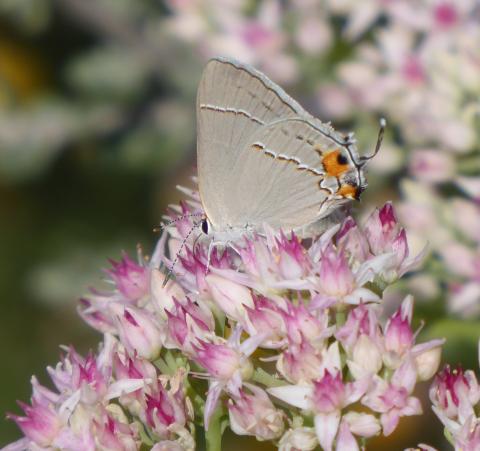 Tall autumn flowering sedums, such as Matrona, Autumn Joy and Frosty Morn varieties. Many of the tall (up to 18-24 inches) fall blooming sedums (non-native) have flat clusters of flowers that are very attractive to many butterflies and other insects. (Photo at left is the gray hairstreak on 'Frosty Morn' sedum.)
Tall autumn flowering sedums, such as Matrona, Autumn Joy and Frosty Morn varieties. Many of the tall (up to 18-24 inches) fall blooming sedums (non-native) have flat clusters of flowers that are very attractive to many butterflies and other insects. (Photo at left is the gray hairstreak on 'Frosty Morn' sedum.)
Flame Acanthus, Anisacanthus quadrifidus v. wrightii. Two to two and a half foot tall shrub with small shiny green leaves and orange-red tubular flowers July into fall. Heat loving and drought tolerant. Flame acanthus is much loved by hummingbirds that visit my garden, and I also noticed bees and butterflies enjoying it too. I was able to get a photo of a monarch feeding on it.
Victoria Blue Salvia, Salvia farinacea ‘Cathedral Deep Blue’. This much hybridized form of the Victoria blue salvia was a pleasant surprise to me. It grows shorter and more compact with more flower spires, and a deeper blue which attracted me, but I was surprised how attractive it was to bees and butterflies. It bloomed sparsely from June to September. About September 1st, I cut it back to half it’s size (down to a foot). Within two weeks it was growing very lushly, and within 5 weeks until our first hard freeze, it became a magnet for bees, butterflies and moths. Every day they appeared to have a feeding frenzy.
Bougainvillea, Bougainvillea glabra. I planted this very showy ornamental shrub in a container solely for it’s brilliant color. To my surprise one afternoon, two Monarch butterflies took turns sampling all the flowers. This only happened for a three day period during the entire summer. Monarchs visited my garden several times and for many weeks, but they appeared to only be attracted to the bougainvillea this one period. No other butterflies came near it. 
Noticing butterflies causes one to notice other things. One thing that became apparent, when a species of flower bloomed, butterflies and bees didn’t rush to it. Sometimes it would take a few weeks. Whether this was because there weren’t butterflies around, or because the nectar wasn’t available, I don’t know. (American Lady on Greenthread flower in Palo Duro Canyon at right Notice the small white dot.)
Zinnia flowers are a case in point. Zinnias are well loved by butterflies, but it did take two week or so of flowering before I observed butterflies feeding on it. Then, early in September, an unusually cold front swooped down to the Texas Panhandle. Not cold enough to freeze, but cold enough to do damage to the zinnias’ appearance. They looked damaged, not dead. It took six weeks before I noted another landing or butterfly feeding on it’s new flowers. During the six week interval, butterflies didn’t even make exploratory sweeping flights across it, flying lower and lower to the flowers, as they had in the past.
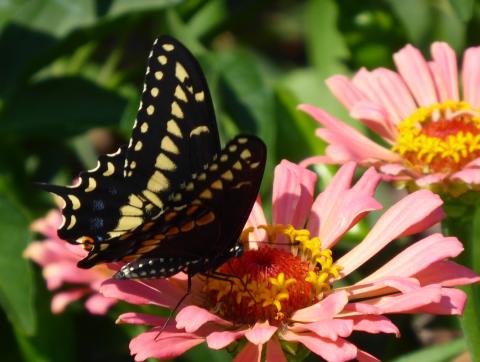 Butterfly Observations
Butterfly ObservationsDuring the past few decades, most attention has been concentrated on the declining population of the Monarch butterfly. But many butterfly species, likewise, are in decline. The main culprits are decreasing habitats (host and nectar plants) because of agriculture and growth of cities, increased use of insecticides, and climate change. So any help by local gardeners everywhere is beneficial to their populations. (Photo at left is black swallowtail on zinnia.)
Even so, in my own small city garden and in observing butterflies at the Amarillo Botanical Gardens, Palo Duro Canyon State Park and Wildcat Bluff Nature Center, I’ve been able to photograph a good number of butterflies the past five years, most of them the past two years. I consider myself a casual or haphazard observer, rather than a dedicated or scientific observer and in no way a butterfly expert. After looking over my photos, and identifying them using Internet butterfly websites, I was surprised at the variety I have seen.
Sprinkled throughout this article are photos of the butterflies I’ve seen, and where locally. To be honest, it was mainly this summer, mostly confined to the home during this Covid-19 year, that I spent much more time actively observing on a day to day, week to week basis, and last spring visiting Palo Duro Canyon State Park during that delightful rainy spring that allowed many wildflowers to flourish. I hope to continue this new pastime in the future.
In Wildcat Bluff and Palo Duro Canyon, most of my sitings were made in May and June. But as the temperature soars, I rarely visit those natural settings for summer hiking. At our home garden and at the Amarillo Botanical Gardens, August, September and October are the months with the most butterfly sitings.
It is quite a thrill to be immersed in a field or patch of flowers that have butterflies and bees fluttering back and forth. Many a hot afternoon would find me out in the sun, watching them fly from plant to plant. I didn’t seem to tire. Often, camera in hand, I’d wait impatiently for just the right angle. This exercise has made me appreciate some of the really fine photographs on the Web. When ever I’d visit the front garden without my camera in hand, I would end up running back inside to get it. After awhile, when working in the garden, I’d have my camera along with me for an opportune shot.
Painted Lady butterflies were most noted in August and early September. By mid September, American Lady butterflies visited the garden. I would notice Eastern Black Swallowtails throughout the summer. On great occasion, I’ll spot a Monarch on it’s way north in the spring, most years not. I would spot one from time to time in July or August. However by September this year, I would see from one to four Monarchs most weeks in September through the end of October on sunny days. In 2018, September brought a large migration south, numbering about a dozen in my garden for several days. Seeing so many of them stopping and taking on nectar for their flight to Mexico was quite exciting. Each year viewing butterflies has been different.
It is only lately that I’ve paid attention to some of the smaller butterflies, the whites and sulphurs, gossamer wings: mainly hairstreaks and blues here. The Gray Hairstreak is a beautiful small butterfly that I’ve seen quite a bit. I’ve noticed several species of skippers but have had a hard time identifying them – it’s a large group.
 Moths mainly fly at night. Therefore, I have only few sightings of them, except for the White-lined Sphinx moth and the Snowberry Clearwing. (Photo at upper right is of white-lined sphinx moth at purple Salvia greggii.)
Moths mainly fly at night. Therefore, I have only few sightings of them, except for the White-lined Sphinx moth and the Snowberry Clearwing. (Photo at upper right is of white-lined sphinx moth at purple Salvia greggii.)
North America is home to more than 12,000 species of butterflies and moths, with moths making up most of the diversity. Texas has over 400 butterfly species known to the state, out of 800 butterfly species known north of Mexico. The organization Butterflies and Moths of North America has checklists narrowed down to the county for those who wish to learn what butterflies and moths they might find where they live. Postings to BAMONA are “made and verified by individual citizen scientists who participate in data collection and review”. It was the most complete list I could find that is narrowed down to particular counties. For Randall County, Texas, (72 species listed) click here; for Potter Country, Texas, (61 listed) click here. I’ve provided a link to the individual butterflies for detailed information.
From large to smaller butterflies and then moths, I have been able to identify these:
Black Swallowtail, Papilio polyxenes, sometimes called the eastern black swallowtail. Never saw more than two at one time, usually only one. Appeared sporadically throughout the summer and fall. (Photo of black swallowtail at the top left of this section on butterfly Observations.)
Monarch, Danaus plexippus. The monarch butterfly is the state insect of Texas and a migrating butterfly. Plants in the milkweed genus are essential to its lifecycle. Monarch butterflies visited my garden many weeks from August into October, right up to our hard freeze and snow this October. For more about the monarch and its migration, click here. (Several monarch photos i n section on My Plants for Butterflies.)
n section on My Plants for Butterflies.)
Queen, Danaus gilippus. One of the milkweed butterflies with a similar look to the Monarch. Queens visited my garden quite often, many times along with the monarchs and in just slightly greater numbers. (Photo of queen on Gregg's Blue Mist flower at upper left.)
Painted Lady, Vanessa cardui. I noticed the Painted Lady often. Over a hundred host plants have been noted, including hollyhocks and mallows. It is similar in appearance to the American lady, which has two eyes on the underside of its wings; the painted lady has four small eyespots on the underside of it’s hind wings. The painted lady also migrates, but not a regular seasonal migration like the monarchs. Painted ladies were present for many weeks, anywhere from four to eight at a time.

American Lady, Vanessa virginiensis. The American lady was a frequent visitor to our garden. Two large eyespots on the underside of its wings, also frequently a small white spot in the orange field near the edge of the forewing. It is easy to mistake the American lady for the painted lady butterfly. I noticed the American Ladies 6-8 weeks after seeing Painted Ladies, usually four to six at a time.
Red Admiral, Vanessa atalanta. I see the red admiral much less frequently as the others. Although it will feed on flowers, it prefers sap from trees. (Photo of Red Admiral at upper right on spotted bee balm in Palo duro Canyon.)
Common Buckeye, Junonia coenia. Attractive with large eyespots. Spotted both in our garden and Palo Duro Canyon, although it's not a regular visitor. (Photo at top of section, Plants for Butterflies, on the right.)
Hackberry Emperor, Asterocampa celtis. Spotted it in Palo Duro Canyon and in our garden. (Photo at upper left of hackberry emperor on spotted bee balm.)
 Pearl Crescent, Phyciodes tharos. A smaller butterfly, only spotted twice. Likes asters, among other flowers. (Photo at upper right on unopened sedum flower head.)
Pearl Crescent, Phyciodes tharos. A smaller butterfly, only spotted twice. Likes asters, among other flowers. (Photo at upper right on unopened sedum flower head.)

Bordered Patch, Chlosyne lacinia. One sighting on Verbena bonariensis. (Photo at right on purple vervain.)
Texan Crescent, Anthanassa texana seminole. Only one sighting in September, 2016 at Amarillo Botanical Gardens. Not listed as a butterfly of Potter or Randall Counties in Texas. (Photo at left on white bedding zinnia.)
Variegated Fritillary, Euptoieta claudia. Several sightings over the years, both in my garden and at Palo Duro Canyon State Park. Hosts plants include the maypop and sedums. (Photo at left on Purple vervain.)
Gulf Fritillary, Dione vanillae. One sighting at Amarillo Botanical Gardens. Not on our regional checklist. (Photo at right.)
Gorgone checkerspot, Chlosyne gorgone or Silvery Checkerspot, Chlosyne nycteis. Sometimes it’s just hard to tell. One sighting in our garden on Boltonia. (Photo in the upper section of My Butterfly Plants at the left.)

Gray Hairstreak, Strymon melinus. My favorite small butterfly. The gray hairstreak visited many different flowers and was spotted often both in our garden and in natural areas. (Photo of Gray hairstreak in the upper section on My Butterfly Plants on the left.)
Reakirt’s Blue, Echinargus isola. Another small gossamer-winged butterfly often seen in natural areas. (Photo of 2 Reakirt's blue on yucca leaves in Palo Duro Canyon at lower right.)
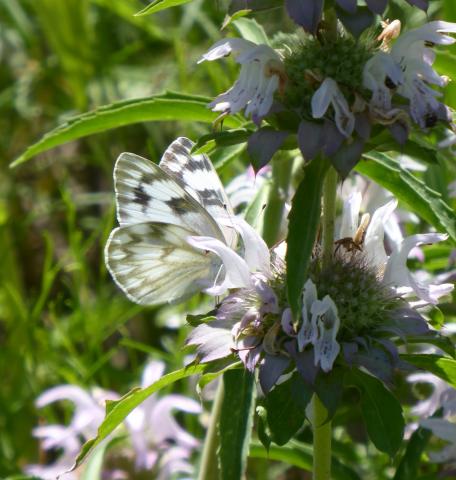 Checkered White, Pontia protodice. One of the whites and sulphers seen in Palo Duro Canyon on the native Monarda. (Photo at left on spotted bee balm. The checkered white appears to mimic the bee balm -- just a coincidence!)
Checkered White, Pontia protodice. One of the whites and sulphers seen in Palo Duro Canyon on the native Monarda. (Photo at left on spotted bee balm. The checkered white appears to mimic the bee balm -- just a coincidence!)
Cloudless Sulphur, Phoebis sennae. I often would see in our garden and in natural areas a yellow sulphur without spotting, although it’s not on the regional list.
Clouded sulphur, Colias philodice. I’ve had frequent sightings both in the garden and nature.
Cabbage White, Pieris rapae. Where there are not other butterflies, there are always a half dozen cabbage whites flying around looking to lay eggs on my brassicas. My least favorite butterfly.

Common Checkered Skipper, Pyrgus communis. A very pleasant small spread-wing skipper that I would often see in our garden and in natural settings. (Photo is at the top of the page on the right in the section My Butterfly Plants.)
Horace’s Duskywing, Erynnis horatius. A little larger spread-wing skipper on a Big Bend Barometer Bush at Amarillo Botanical Gardens. Also one sighting in Palo Duro Canyon State Park. (Photo black-brown butterfly at lower right.)
Sachem, Atalopedes campestris. A fairly common skipper with a wide range on a sunflower in our backyard. (Photo of sachem on sunflower at left.)
Fiery Skipper, Hylephila phyleus. I could be wrong on its ID. Not listed on the regional list. I noticed a number of different skippers in our garden, and of course, natural surroundings. (Photo at lower right on purple vervain.)
Snowberry clearwing, Hemaris diffinis. A sphinx or hawkmoth, but looks like a big wasp. Often observed in the afternoons in our garden. (Photo at lower left on rose flower of butterfly bush.)
White-Lined Sphinx, Hyles lineata. This sphinx or hawkmoth is often mistaken for a hummingbird. It’s active during the day, at dusk and at night. Visits many tubular flowers, including most of my salvias. (Photo at left at the top of this section on Butterfly Observations.)


My plan is to continue to observe butterflies in our area in the years to come, because of the enjoyment in seeing this wonderful “flying flowers”. To simply step out the front door for many weeks in the summer to view these colorful insects is better than visiting butterfly pavilions. I hope you will join in the fun and at the same time help preserve a little biodiversity.
Resources
Attracting Native Pollinators, A Xerces Society Guide, Storey Publishing, 2011.
Butterflies and Moths of North America, dedicated to collecting and sharing data about Lepidoptera. Check out the butterflies and moths in your regional checklist – down to the county!
Butterflies at Home, List of Texas butterflies.
Butterflyidentification.org List of Texas butterflies.
Butterfly Nectar and Host Plants for Central Texas Butterflies, Austin Butterfly Forum
Dallasbutterflies.org List of butterflies of the Dallas area and host plants.
The Garden in Autumn, by Allen Lacy, The Atlantic Monthly Press, 1990.
Gardening for Butterflies: How You Can Attract and Protect Beautiful, Beneficial Insects
by The Xerces Society, Timber Press.
Larval Host Plants for Central Texas Butterflies, Native Plant Society of Texas
Pollinator Plants for the Southern Plains Region, Xerces Society
Angie Hanna, October 2020